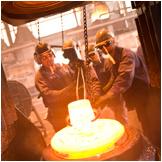The Differences Between 3 Open Die Forging Techniques
Some industrial processes have been around for centuries. While many processes cease for a newer method others evolve with new technology, but keep the same basic principles. One industry that has kept these principles is open die forging. This process is still sometimes referred to as smith forging. The reason this method has stood the test of time is because of its numerous benefits. To start, open die forging can be done hot or cold, it is easier to modify large pieces of metal, all while increasing the strength of the product and reducing porosity. There are three processes that make up this style of forging and those are cogging, fullering and edging. Each process fabricates the metal in a different way for diverse applications.
Open die forging is applicable to more than steel and steel alloys. Other metals that are used in the smith forging processes are copper, titanium and nickel alloys. This process is called open die because the metal is places on an anvil with no sides restricting the movement of the metal workpiece. Because there are no side restrictions, when the workpiece is hit with the die it forces the material to flow in certain directions.
Cogging
The process called cogging is used in order to work a piece of raw material into the correct thickness and increasing length. The metal bar is hit with a die successively to deform the bar on the entirety of its length. The die is typically flat but can be slightly contoured. After the bar is at its desired thickness and length, the bar is ready for the next step in the open die forging process, edging or fullering.
Fullering
The fullering process is usually used in earlier steps to help prepare the metal for further forging. Fullering is similar to cogging. However, fullering thins out sections of the forging using a convex shaped die. When the die hits it applies force to the metal material resulting in deformation of the workpiece. When hit the material flows out of the area of concentration and both sides, making the point of impact thinner.
Edging
Edging is also an open die forging process. In edging, the die is a concave shape. The flow of material on impact of the die is the opposite of fullering. When the concave die deforms the workpiece the material flows into the die area from both sides. The process is called edging because it is usually carried out on the edges of the workpiece. Fullering and edging are both utilized to move around bulk quantities of the workpiece material.

Photo Courtesy of Clifford-Jacobs Forging Company
For centuries, the general idea of open die forging has stayed the same, but the equipment and processes have been refined over time. Whether you are using the cogging, fullering, edging process or all three, each is important to forging. Although, there are many other ways to forge a workpiece, the open die forging processes will always have a place in the forging world. How do you and your company use open die forging? Which process do you find yourself using the most: cogging, fullering or edging?


 Castings & Forgings
Castings & Forgings Bulk Material Handling
Bulk Material Handling Electrical & Electronic Components
Electrical & Electronic Components Flow Instrumentation
Flow Instrumentation Hardware
Hardware Material Handling Equipment
Material Handling Equipment Metal Cutting Services
Metal Cutting Services Metal Forming Services
Metal Forming Services Metal Suppliers
Metal Suppliers Motion Control Products
Motion Control Products Plant & Facility Equipment
Plant & Facility Equipment Plant & Facility Supplies
Plant & Facility Supplies Plastic Molding Processes
Plastic Molding Processes Pumps & Valves
Pumps & Valves Recycling Equipment
Recycling Equipment Rubber Products & Services
Rubber Products & Services